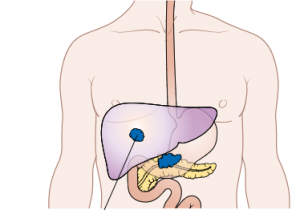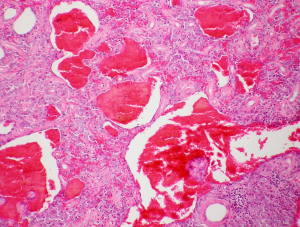Jack’s Health Part E: Liver Cancer
Due to Jack’s history with alcohol, he began to experience abdominal pain and swelling.
At times, when he went to work, his co-workers would point out that his eyes and skin appear yellow. Jack books an appointment with his doctor to find out why he has these symptoms.
During his appointment, the doctor collects information, performs a physical examination and ultrasound along with blood work. Unfortunately, his doctor diagnosed him with grade I malignant liver cancer.
Benign vs. Malignant
Benign Neoplasms
- Grow slowly
- Well-defined capsule (borders)
- Low mitotic index
- Not invasive
- Well-differentiated
- Does not spread to other organs
Malignant Neoplasms
- Grow rapidly
- Not encapsulated (ill – defined borders)
- High mitotic index
- Invade & destroy local tissues
- May not look like tissue of origin
- Can metastasize
Pathophysiology
Proliferative patterns. Cancerous cells are described as malignant neoplasms because they demonstrate uncontrolled cellular growth that follows no physiologic demand (neoplasia).
Characteristics of malignant cells
- Cells are undifferentiated and bear little resemblance to normal cells
- They grow at the periphery and infiltrate and destroy surrounding tissues
- The rate of their growth is variable and depends on level of differentiation
- They can gain access to the blood and lymphatic channels and metastasizes to other areas of the body
- They often cause as anemia, weakness, and weight loss, extensive tissue damage and death
What is Liver Cancer?
- Liver cancer occurs when liver cells develop changes (mutations) in their DNA
- A cell’s DNA is the material that provides instructions for every chemical process in your body. DNA mutations cause changes in these instructions
- Cells may begin to grow out of control and eventually form a tumor — a mass of cancerous cells

Pathophysiology of Liver Cancer
Carcinogenesis is a malignant transformation that involves initiation, promotion, and progression.
- Initiation: (initiators such as chemicals, physical factors, and biologic agents, escape normal enzymatic mechanisms and alter the genetic structure of the cellular DNA)
- Promotion: (repeated exposure to carcinogens causes the expression of abnormal or mutant genetics information)
- Progression: (the altered cells exhibit increased malignant behavior)
- Invasion and metastasis: Malignant disease processes have the ability to allow the spread or transfer of cancerous cells from one organ or body part to another by invasion (growth of the primary tumor into the surrounding host tissues) and metastasis (dissemination or spread of malignant cells from the primary tumor to distant sites.

What phase is Jack’s liver cancer in?
Tumor Staging & Grading
A complete diagnostic evaluation include identifying the stage and grade of the tumor
Staging: It determines the size of the tumor and the existence of local invasion and distant metastasis.
Tumor, Nodes, and Metastasis (TNM) system: The TNM system is frequently used, where T is the extent of the primary tumor, N is the absence or presence and extent of regional lymph node metastasis, and M is the absence or presence of distant metastasis.
Jack’s Grade I liver cancer
Grading
Grading refers to the classification of the tumor cells, and it seeks to define the type of tissue from which the tumor originated and the degree to which the tumor cells retain the functional and histologic characteristics of the tissue of origin.
Grade I to IV
Grade I tumors, also known as well-differentiated tumors, closely resemble the tissue of origin in structure and function while Grade IV tumors do not clearly resemble the tissue of origin in structure and function.
The Role of the Immune system
Some evidence indicates that the immune system can detect the development of malignant cells and destroy them before cell growth becomes uncontrolled. If the immune system fails to identify and stop the growth of malignant cells, clinical cancer develops. Monocytes can detect the presence of cancer

Risk Factors
Excessive alcohol consumption: Consuming more than a moderate amount of alcohol daily over many years can lead to irreversible liver damage and increase your risk of liver cancer.
Diabetes: People with this blood sugar disorder have a greater risk of liver cancer than those who don’t have diabetes.
Nonalcoholic fatty liver disease: An accumulation of fat in the liver increases the risk of liver cancer.
Which of these risk factors does Jack have?
Jack receives radiation therapy for his cancer
Safety Precautions: Safety precautions used in Jack’s brachytherapy include assigning him to a private room, posting appropriate notices about radiation safety precautions, having safety measures for staff and prohibiting/limiting visits to the patient
Symptoms: the nurse should explain that these symptoms are a result of the treatment and do not represent deterioration or progression of the disease.
Safety precautions: having staff members wear dosimeter badges, making sure that pregnant staff members are not assigned to the patient’s care, prohibiting visits by children and pregnant visitors, limiting visits from others to 30 minutes daily, and seeing that visitors maintain a 6 foot distance from the radiation source.

